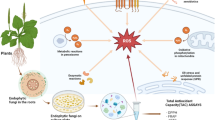Abstract
The purpose of this study was to characterize the cellular response and proteomic analysis of Escherichia coli exposed to tea polyphenols (TPP) extracted from Korean green tea (Camellia sinensis L). TPP showed a dose-dependent bactericidal effect on E. coli. Analysis of cell-membrane fatty acids of E. coli cultures treated with TPP identified unique changes in saturated and unsaturated fatty acids, whereas scanning electron microscopic analysis demonstrated the presence of perforations and irregular rod forms with wrinkled surfaces in cells treated with TPP. Two-dimensional polyacrylamide gel electrophoresis of soluble protein fractions from E. coli cultures exposed to TPP showed 17 protein spots increased or decreased by TPP. Nine upregulated proteins were identified (including GroEL and proteins involved in cellular defense, such as GyrA, RpoS, SodC, and EmrK), whereas the expression of eight proteins was downregulated by exposure to TPP (including proteins involved in carbon and energy metabolism, such as Eno, SdhA, and UgpQ, as well as those involved in amino-acid biosynthesis, such as GltK and TyrB). These results provide clues for understanding the mechanism of TPP-induced stress and cytotoxicity on E. coli.




Similar content being viewed by others
References
Ahn YJ, Kawamura T, Kim M, Yamamoto T, Mitsuoka T (1991) Tea polyphenols: Selective growth inhibitors of Clostridium spp. Agric Biol Chem 55:1425–1426
Cabrera C, Artacho R, Gimenez R (2006) Beneficial effects of green tea—A review. J Am Coll Nutr 25(2):79–99
Chang HW, Kahng HY, Kim SI, Chun JW, Oh KH (2004) Characterization of Pseudomonas sp. HK-6 cells responding to explosive RDX (hexahydro-1,3,5-trinitro-1,35-triazine). Appl Microbiol Biotechnol 65:323–329
Cho YS, Kahng HY, Kim CK, Kukor JJ, Oh KH (2002) Physiological cellular responses of the 2,4-D degrading bacterium, Burkholderia cepacia YK-2, to the phenoxyherbicides 2,4-D and 2,4,5-T. Curr Microbiol 45:415–422
Cowan MM (1999) Plant products as antimicrobial agents. Clin Microbiol Rev 12(4):564–582
Hamilton-Miller JMT (1995) Antimicrobial properties of tea (Camellia sinensis L.). Antimicrob Agents Chemother 39:2375–2377
Hirasawa M, Takada K (2004) Multiple effects of green tea catechin on the antifungal activity of antimycotics against Candida albicans. J Antimicrobiol Chemother 53:225–229
Ho EM, Chang HW, Kim SI, Kahng HY, Oh KH (2004) Analysis of TNT (2,4,6-trinitrotoluene)-inducible cellular responses and stress shock proteome in Stenotrophomonas sp. OK-5. Curr Microbiol 49:346–352
Ikigai H, Nakae T, Hara Y, Shimamura T (1993) Bactericidal catechins damage the lipid bilayer. Biochim Biophys Acta 1147:132–136
Jungblut PR, Bumann D, Hass G, Zimny-Arndt U, Holland P, Lamer S, et al. (2000) Comparative proteome analysis of Helicobacter pylori. Mol Microbiol 36:710–725
Jungblut PR, Schaible UE, Mollenkopf HJ, Zimny-Arndt U, Raupach B, Mattow J, et al. (1999) Comparative proteome analysis of Mycobacterium tuberculosis and Mycobacterium bovis BCG strains: Toward functional genomics of microbial pathogens. Mol Microbiol 33:1103–1117
Navarro-Martinez MD, Navarro-Peran E, Cabezas-Herrera J, Ruiz-Gomez J, Garcia-Canovas F, Rodriguez-Lopez JN (2005) Antifolate activity of epiallocatechin gallate against Stenotrophomonas maltophilia. Antimicrob Agents Chemother 49:2914–2920
Park SH, Oh KH, Kim CK (2001) Adaptative and cross-protective responses of Pseudomonas sp. DJ-12 to several aromatics and other stress shocks. Curr Microbiol 43:176–181
Pertins DN, Pappin DJ, Creasy DM, Cottrell JS (1999) Probability-based protein identification by searching sequence databases using mass spectrometry data. Electrophoresis 20:355–3567
Schmid R, Bernhardt J, Antelmann H, Volker A, Mach H, Volker U, et al. (1997) Identification of vegetative proteins for a two-dimensional protein index of Bacillus subtilis. Microbiology 143:991–998
Toda M, Okubo S, Hiyoshi R, Shimamura T (1989) The bactericidal activity of tea and coffee. Lett Appl Microbiol 8:123–125
Yam TS, Shah S, Hamilton-Miller JMT (1997) Microbiological activity of whole and fractionated crude extracts of tea (Camellia sinensis), and of tea components. FEMS Microbiol Lett 152:169–174
Yang CS, Landau JM (2000) Effects of tea consumption on nutrition and health. J Nutr 130:2409–2412
Acknowledgment
This research was accomplished while one of the authors (K. H. O.) was on sabbatical leave (2006 through 2007) from Soonchunhyang University.
Author information
Authors and Affiliations
Corresponding author
Rights and permissions
About this article
Cite this article
Cho, Y.S., Schiller, N.L., Kahng, H.Y. et al. Cellular Responses and Proteomic Analysis of Escherichia coli Exposed to Green Tea Polyphenols. Curr Microbiol 55, 501–506 (2007). https://doi.org/10.1007/s00284-007-9021-8
Received:
Accepted:
Published:
Issue Date:
DOI: https://doi.org/10.1007/s00284-007-9021-8




